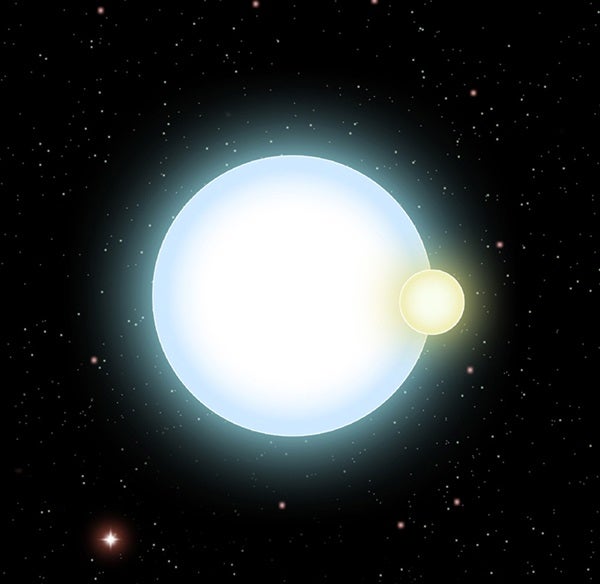Astrophysicists at the University of California, Santa Barbara (UCSB), are the first scientists to identify two white dwarf stars in an eclipsing binary system, allowing for the first direct radius measurement of a rare white dwarf composed of pure helium. These observations are the first to confirm a theory about a certain type of white dwarf star.
The story began with observations by Justin Steinfadt, a UCSB physics graduate student who has been monitoring white dwarf stars.
Steinfadt discovered brief eclipses during observations of the star NLTT 11748 with the Faulkes Telescope North of the Las Cumbres Observatory Global Telescope (LCOGT), a UCSB-affiliated institution. NLTT 11748 is one of the few low-mass, helium-core white dwarfs that are under careful study for their brightness variations. Rapid snapshots of the star — about one exposure every minute — found a few consecutive images where the star was slightly fainter. Steinfadt quickly realized the importance of this unexpected discovery. “We’ve been looking at a lot of stars, but I still think we got lucky!” he said.
Avi Shporer at UCSB and the LCOGT assisted with the observations and quickly brought his expertise to the new discovery. “We knew something was unusual, especially as we confirmed these dips the next night,” Shporer said. The scientists observed 3-minute eclipses of the binary stars twice during the 5.6-hour orbit.
The excitement of the discovery and the need to confirm it rapidly led to the use of the 10-meter Keck telescope, located on Mauna Kea in Hawaii, just 5 weeks after the first observation. The team also brought in David Kaplan, a Hubble Fellow and Kavli Institute for Theoretical Physics postdoctoral fellow.
During that night, the scientists were able to measure the changing Doppler shift of the star NLTT 11748 as it orbited its faint but more massive white dwarf companion. “It was amazing to witness the velocity of this star change in just a few minutes,” said Kaplan, who was present at the Keck telescope during the observations.
These observations led to the confirmation of an important theory about white dwarf stars. Stars end their lives in many ways. “The formation of such a binary system containing an extremely low-mass helium white dwarf has to be the result of interactions and mass loss between the two original stars,” said Howell. White dwarf stars are the dense remnants of stars like the Sun, with dimensions comparable to Earth. A star becomes a white dwarf when it has exhausted its nuclear fuel and all that remains is the dense inner core, typically made of carbon and oxygen.
One of the stars in the newly discovered binary is a relatively rare helium-core white dwarf with a mass of only 10 to 20 percent of the Sun. The existence of these special stars has been known for more than 20 years. Theoretical work predicted that these stars burn hotter and are larger than ordinary white dwarfs. Until now, their size had never been measured. The observations of the star NLTT 11748 by this research group have yielded the first direct radius measurement of an unusual white dwarf that confirms this theory.
The other star in the binary is also a white dwarf, albeit a more ordinary one composed of mostly carbon and oxygen with about 70 percent of the mass of the Sun. This star is more massive and also much smaller than the other white dwarf. The light it gives off is 30 times fainter than that of its partner star in the binary.










